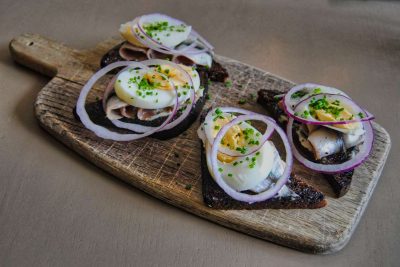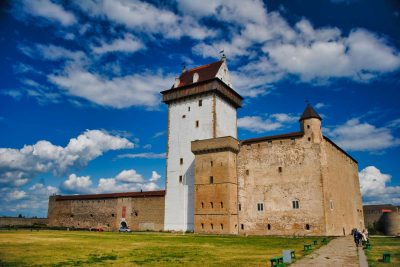Considering that Estonians sometimes refer to their country as the “most atheistic country in the world”, Christmas is surprisingly present in Estonia. The city centers are festively decorated, no store or café is without opulent Christmas decorations. When there is snow at Christmas, Estonian cities such as Tallinn, Tartu and Pärnu are transformed into a real winter wonderland. The chances of a white Christmas are still good, even if they can no longer be taken for granted, as climate change sends its regards even at almost 60° north.

Was the first Christmas tree put up in Tallinn?
Even if the church does not play a major role in Estonia today, and the Soviet occupation period has done its part to cause Christian traditions to be forgotten, the roots of Christmas in Estonia run deep. Tallinn claims one of the oldest documented Christmas trees in the world: as early as 1441, it was erected in Town Hall Square, where it now gleams again against the backdrop of Gothic facades. Whether it was really Tallinn where the first decorated public Christmas tree was erected or not, it is certain that the Lutheran Baltic States had their share in the fact that we put up Christmas trees today!
Appetite comes with food
What else goes with Christmas in Estonia? Of course, good food! But neither Christmas goose nor fondue and raclette are on the table. It has to be traditional and the German roots of many Estonian traditions are clearly visible here: Roast pork, sauerkraut and potatoes form the basis of the Estonian Christmas meal, refined with pickled pumpkin and lingonberry jam. Of course, every family has its own preferences. A traditional festive table in Estonia often includes potato salad, the beet salad rosolje or the layered herring salad kasukas (“fur coat”). Bread, sour cream and pickles can be found on every table anyway. Liver pâté and brawn are also popular. The choice of dishes is therefore hearty, leavened and traditional. You can find our article with the most delicious dishes of Estonian cuisine here.

Estonian hipster brewers
While the festive feasts at Christmas in Estonia are somewhat old-fashioned, Estonian brewers are at the forefront of international beer trends. Käsitööõlu, or “craft beer “, not only has a tongue-twisting name in Estonian, but is also offered in endless variety and top quality. Many bottles and cans are also creatively designed and make great souvenirs. Well-known microbreweries include Põhjala, Pühaste, Pihtla, Pöide and Purtse. The Association of Estonian Microbreweries has over 30 members who offer a fantastic range of beers, including IPA, porter and other special Christmas beers. The word “Christmas beer” alone is a feast for the eyes in Estonian, as it reads: jõuluõlu.

A pretty cookie for everyone
The Estonian counterpart to Christmas cookies is piparkoogid – gingerbread. The firm, dark brown and aromatic cookies are an integral part of Christmas celebrations in Estonia. The basic dough is quick to prepare or can be bought ready-made and keeps for a long time in the fridge. When it is time for the next slide, it is rolled out, cut out with molds and baked. Then the gingerbread cookies can be refined as desired, especially with colorful sugar paste, so that the almost inconspicuous cookies become small, sparkling works of art. The supreme discipline is the gingerbread house in a glittering powdered sugar landscape.

It’s about the bloody sausage!
One ingredient for Christmas in Estonia is still missing. The unlikely star of the chiller cabinet and a matter of the heart for many Estonians, the subject of national discussions, analyses and votes: black pudding! What Serrano ham is to the Spanish and Thanksgiving turkey is to the Americans, verivorst, or blood sausage, is to Estonians. If you’re thinking of the reddish, sliceable black pudding that you might find on a traditional German dinner table, you’re wrong.
Estonian black pudding looks like a thick, short sausage, is brownish-black and is served hot. The skin gets crispy and holds the mushy, coarse-grained contents together. What may sound off-putting to many – except die-hard fans of exotic foods – is actually really tasty. Aromatically spiced in winter, warming and quaint, black pudding is just the thing when it gets crispy cold outside and your body is calling for energy. So: Just give it a try.
Santa Claus comes to the test
Another special feature of the Estonian Christmas season must be mentioned here, the jõuluvana, or “Christmas old man”. This Santa Claus may not look any different than anywhere else, but his role is special. And it is very fitting for the eternal striver among the post-Soviet states: Estonia has solid public finances, consistently wins in the PISA study, is a frontrunner in digitalization and shines with impressive economic growth rates. Why does it all work so well in Estonia? Maybe it’s also because of the jõuluvana? He acts like a good-natured teacher taking an exam.
Did you learn your Christmas poem?
Estonian Santa Claus comes in the form of relatives, teachers and educators, neighbors or trained actors (!) to give presents to Estonian families, schools and kindergartens or sports clubs. He then asks the children and adults whether they have been good and hard-working. Then poems are recited to the jõuluvana, songs are sung, pieces of music are played or danced. As a reward, the old man hands out the presents. But the deal is clear: you have to perform and be able to do something, then you’ll get something. The most important thing is that you make an effort. And so the tricks are performed with great seriousness and effort. In the end, Santa’s visit is of course a cheerful and contemplative event, but nevertheless: performance is worthwhile!

Magic landscape and cultural enjoyment
These and other special features of the Estonian Christmas season can be experienced during a visit to Estonia in winter. The cultural calendar is well filled, from Christmas concerts by many artists and choirs to the Christmas Jazz Festival and the PÖFF Dark Nights Film Festival. With a bit of luck, the white carpet of snow spreads across the landscape and a magical atmosphere fills the festively illuminated towns. Of course, the Estonian tourism industry has also discovered that this can be marketed. The Tallinn Christmas market with its festively illuminated stalls, the finest arts and crafts and the historic facades in the background is absolutely instagrammable. And so you are no longer alone when you stroll through Tallinn’s old town streets at this time of year. But the atmosphere is always contemplative and contemplative. So: Häid jõule! – Merry Christmas!
Are you curious and want to get to know Estonia better? Then get your hands on the travel guide “Baltic States”, which I published together with other experts at Reise Know-How Verlag. Here you will not only find lots of information about your Estonian vacation, but also about Lithuania and Latvia.
No products found.
Have you ever celebrated Christmas in Estonia? Which Estonian Christmas tradition do you like best? Feel free to leave us a comment!



